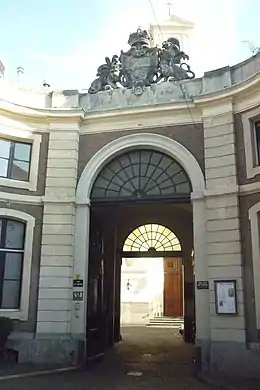Sir Richard Sykes | |
|---|---|
| British Ambassador to the Netherlands | |
| In office June 1977 – 22 March 1979 | |
| Monarch | Elizabeth II |
| Prime Minister | James Callaghan |
| Preceded by | Ernest John Ward Barnes |
| Succeeded by | Sir Jock Taylor |
| Personal details | |
| Born | 8 May 1920 Brentford, Middlesex, England |
| Died | 22 March 1979 (aged 58) The Hague, Netherlands |
| Spouse |
Ann Georgina Fisher (m. 1953) |
| Education | Wellington College |
| Alma mater | Christ Church, Oxford |
| Profession | Diplomat |
| Military service | |
| Allegiance | United Kingdom |
| Branch/service | British Army |
| Years of service | 1940–1946 |
| Rank | Major |
| Unit | Royal Corps of Signals |
| Battles/wars | Second World War |
| Awards | Knight Commander of the Order of St Michael and St George Military Cross Croix de Guerre (France) |

Sir Richard Adam Sykes, KCMG, MC (8 May 1920 – 22 March 1979) was the British Ambassador to the Netherlands, who was assassinated by the IRA in The Hague in 1979.
Early life
Richard Sykes was born on 8 May 1920 to Brigadier A. C. Sykes. He was educated at Wellington College and Christ Church, University of Oxford.[1]
Second World War
During the Second World War, Sykes served in the British Army with the Royal Signals from 1940 to 1946, attaining the rank of major.[1] In 1945 he was awarded the Military Cross as well as the French Croix de Guerre.[2]
Diplomatic career
Sykes joined HM Foreign Service in 1947 and served at the Foreign Office from 1947 to 1948. He then served in Nanking (1948–50), Peking (1950–52) and returned to the UK to serve at the Foreign Office (1952–56).[1] His next overseas postings took him to Brussels (1956–59), Santiago (1959–62) and Athens (1963–66), before returning to the Foreign Office (1967–69).[1]
Sykes' first posting as an ambassador came with a posting to Havana (1970–72) before moving to be a Minister at the British Embassy in Washington D.C. (1972–1975). From there he returned to the Foreign Office as Department Under-Secretary between 1975 and 1977. Sykes was then appointed as Ambassador to the Netherlands in 1977.[1]
Assassination
Sykes was leaving his residence in The Hague at 9 am and was getting into his silver Rolls-Royce limousine when he was shot. He was sitting next to Alyson Bailes. The car door was held by Karel Straub, a 19-year-old Dutch national who worked at the embassy. Straub was also shot in the attack.[3]
Sykes' chauffeur, Jack Wilson, was uninjured and drove Sykes to Westeinde Hospital, where he died two hours later. Straub was transported by ambulance to the same hospital, where he also died.[3]
Police reported that the shots came from around 10 yards (9 m) away, fired by two men wearing business suits, who escaped on foot following the attack.[3] Later that day, André Michaux, a senior bank official from Belgium, was murdered outside his home in Brussels in a case of mistaken identity; Sir John Killick – British Deputy Ambassador to NATO, who lived opposite Michaux – was believed to be the intended target of the IRA.[4][5]
Suspects for the assassination were Palestinians or Iraqis, although no evidence was ever put forward. It was ultimately confirmed that the IRA had carried out the killings.[6]
The IRA claimed responsibility for the assassination in February 1980. In a statement they said of Sykes: "[he was] not just a Brit propagandist, as are all British ambassadors, but because he had been engaged in intelligence operations against our organisation."[7]
The 'intelligence operations' mentioned in the statement related to a government report written by Sykes following the assassination of Christopher Ewart-Biggs. Ewart-Biggs was the British Ambassador to the Republic of Ireland and was killed by the IRA in 1976. Sykes produced diplomatic security guidelines as part of his report.[7]
Sykes' position as Ambassador to the Netherlands had been strained due to certain Dutch groups, which were sympathetic to the IRA, and consequent arms smuggling activities.[8][9][10][11]
Family
Sykes was married to Ann, Lady Sykes (née Fisher). The couple had three children. Lady Sykes died in 2018.
Memorials
There is a memorial plaque to Sykes in St Michael's Church, Wilsford, Wiltshire.[12]
See also
References
- 1 2 3 4 5 "Sykes, Sir Richard, (8 May 1920–22 March 1979), HM Diplomatic Service; Ambassador to the Netherlands, since 1977 | WHO'S WHO & WHO WAS WHO". www.ukwhoswho.com. doi:10.1093/ww/9780199540884.013.U160110. ISBN 978-0-19-954089-1. Retrieved 24 March 2019.
- ↑ "The Military Cross". The London Gazette (Supplement – 37302). 9 October 1945. p. 4999.
- 1 2 3 Downie Jr., Leonard (23 March 1979). "British Envoy To Netherlands Shot to Death". The Washington Post.
- ↑ "I.r.a. Sets off Bomb at Belgian Concert". The New York Times. 29 August 1979.
- ↑ "Uniting Innocent Victims" (PDF). South East Fermanagh Foundation. 2018. Retrieved 18 August 2022.
- ↑ BBC coverage of Sykes/Straub assassinations, accessed 30 August 2014.
- 1 2 Lost lives : the stories of the men, women and children who died as a result of the Northern Ireland troubles. McKittrick, David, 1949– ([Rev. ed.] ed.). Edinburgh: Mainstream. 2001. ISBN 184018504X. OCLC 46944614.
{{cite book}}: CS1 maint: others (link) - ↑ The Guardian coverage of Sykes/Straub assassinations, theguardian.com, accessed 30 August 2014.
- ↑ Straub profile, cain.ulst.ac.uk; accessed 6 August 2014.
- ↑ Assassination details, cain.ulst.ac.uk; accessed 6 August 2014.
- ↑ Report on assassinations, time.com; accessed 6 August 2014.
- ↑ "Church of St. Michael, Wilsford cum Lake: Memorial to the British ambassador to the Netherlands Richard Sykes". Wiltshire Community History. Wiltshire Council. Archived from the original on 27 March 2018. Retrieved 24 May 2020.